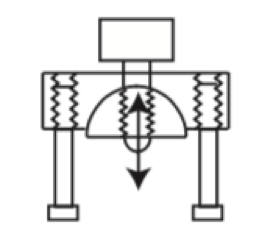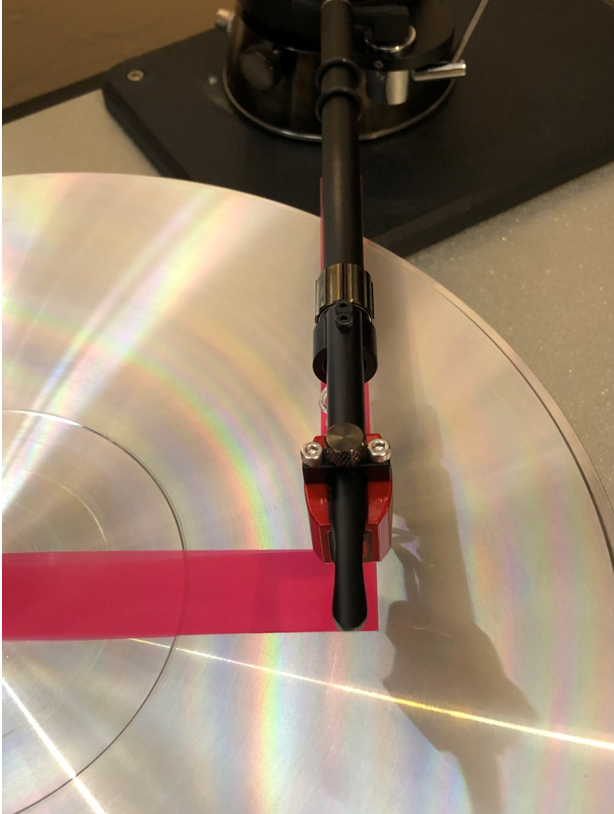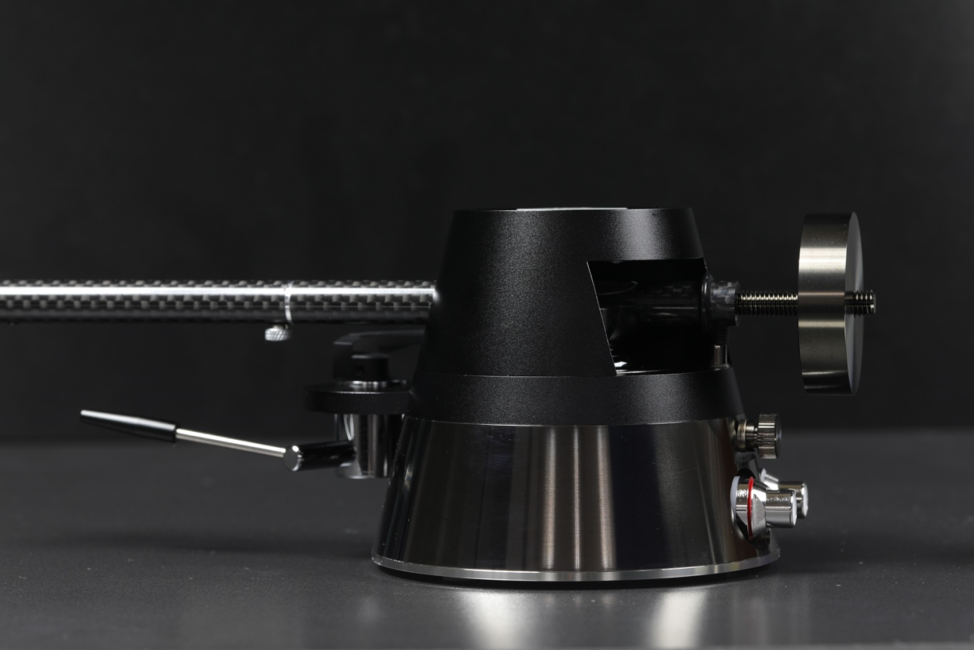
Moving on from the technical details in Part 1, this second part of the review of the ViV Lab Rigid Float/HA Tonearm focuses on setting it up and how it sounds. So, let’s get going.
Setting Up the Cartridge

The ViV Lab arm comes with a detachable headshell that features their “Nelson Hold” design shown above. It features 4N pure silver wires and rhodium-plated connectors. You attach the cartridge to the two outer screws in the crossbar. Then, use the middle thumbscrew through one of the three holes in the armtube. This provides a stabilizing force for the body of the cartridge (shown by the arrow). This design reduces cartridge resonance and gives you the ability to “tune” the cartridge by varying the center screw force on the cartridge motor mechanism.
Setting Up the Tonearm

To find the correct location for the base of the tonearm, use the L-shaped protractor provided. It has a hole for the turntable spindle, and there is a pinhole at the right angle section of the protractor. You want to hover the stylus over the pinhole and move the tonearm base until the arm tube is in alignment with the protractor, as shown in the picture above. Once you are in the ballpark, you can fine-tune the position to get it perfectly aligned. This process took me all of about 5 minutes. Since this is a floating unipivot design, you want to be sure your turntable and the arm are perfectly level. A very nice bubble level built into the arm helps you accomplish this important task.
Next, use the three different-sized counterweights included with the tonearm to set the tracking force. You can use multiple weights for heavier cartridges. Be patient with this as it takes a bit of time for the ferrofluid to settle to get an accurate tracking force reading. I would advise leaving it on your tracking force gauge for about 10 seconds to make sure you get a true reading. As with any tonearm, you want to use the number of weights that get you closest to the tonearm bearing to reduce forces that make tracking any warps less accurate.
Azimuth adjustment is next. To do this, release the thumbscrew on the tonearm shaft. Then twist the arm tube to make any adjustments you need. I will note that the position of the azimuth release screw could be better thought out. It is located on the underside of the arm tube right in front of the cueing platform.
Arm Height Adjustments

To adjust the arm height, you release two screws and raise or lower the arm. One screw is a thumbscrew and the other is a countersunk Allen-head screw. Since there are no markings to use as a reference, small adjustments can be hit or miss. The old “deck of playing cards method” comes in handy here. Simply use a deck of playing cards as “shims” to fill the space between the arm and the base and add or subtract cards as you make adjustments. If you want to lower the arm just a hair, release the VTA lock screw and pull out one card. Allow the arm to drop down, and retighten the VTA lock screw. I typically cut the deck of cards in half and then cut out a semi-circle so the cards can tuck in around the arm pillar. A set of flat “feeler gauges” works well also.
Tuning Ability
There’s also some tuning ability with the tonearm. It has three O-rings on the arm pipe that you can move to change the resonance characteristics. The arm pipe itself is a single-wall design with no internal damping. This allows the O-rings to provide different levels of damping depending on their position.
The tonearm wiring is 4N pure silver line with cryogenic treatment, which provides extremely low resistance for low impedance cartridges. Each of the RCA outputs at the base of the arm (i.e., R+, R-, L+, L-) is insulated from the ground connection (GND). The design allows the Rigid Float Tonearm to be used with true-balanced input phono stages. There is an independent ground pin for balanced output if needed.
One More Thing
One other thing I want to comment on is the armrest. This may be the best armrest design I have had the pleasure of using. It is magnetic, and as you move the arm over to the rest position you get a satisfying “click” as it seats in the armrest. Move it a bit further to the right to put the arm in the lock position. Once you use this feature a few times, it will spoil you, and you will wish more arms had this feature. Kudos on this design!!
So, What About the Sound?
How can something that breaks so many “rules” sound so good? Maybe it is precisely because it breaks the “rules.” I had planned a two-month review of this tonearm. It turned into four months because I simply couldn’t get enough of what this tonearm did with my cartridges.
I threw every cartridge I had on hand at this arm, and each one of them sounded as good as or better than they ever have. This ranged from a Denon 103R to the wonderful new HANA Umami Red that I just recently reviewed.
My Micro Benz LP-S sounded wonderful, but the match made in heaven was with my DS Audio Master One. I suspect the arm’s extremely low resonance combined with its excellent isolation allowed every nuance of the optical cartridge to shine through. Add in the lack of competing side force biases, and this cartridge is “freed up” to sound even more effortless.
The ViV Lab Rigid Float arm sound is the closest thing I have heard to a properly set up tangential arm with a lot less cost and hassle. It allows the cartridge to transmit the characteristics I love in a system. I’m referring to those characteristics that make me put everything down and listen, wonderful micro and macro dynamics, with an effortless flow of the music residing in a huge stable soundstage that enables individual instruments to talk to me.
No More Fighting
You never get the feeling that the cartridge is fighting to produce sound or that there is something that is holding it back from delivering everything it is capable of. It is tonally the most neutral arm I have experienced. Bass reproduction was the best, both in-depth and detail, that I have gotten out of my cartridges. The timbre accuracy was extraordinary. Each album I listened to fully held my attention.
Add on top of that, the obvious lack of resonance in the arm and the isolation from resonances transferred from the table to the arm made hearing each cartridge’s characteristics easily identifiable.
Finally, what about the tracking error distortion that Viv Lab ignored? I have to say, I never heard any tracking distortion from the first cut to the last. It gave me the same feeling I get with a straight line arm. The quality and presentation of the sound remained consistent throughout the whole side of the album. Simply put, this is one excellent sounding tonearm.
I’ll Second That!
A number of you that I have corresponded with have asked me about the idea of adding a second tonearm to your turntable. Many times this question was from readers who had using a mono cartridge in mind. Most of the time, this would involve changing out your turntable to get the ability to add a second tonearm. This is a MAJOR expense both in dollars and in system setup and configuration.
With the ViV Labs design, you can easily add a second arm to your current turntable without having to swallow the “financial pill” of changing out the entire turntable. However, I will warn you, once you hear the ViV labs arm, it may quickly become your primary arm.
In the end, I decided to purchase this arm to have on hand for two reasons:
- As a reviewer, I feel it is an arm that will provide a fairness platform to assess cartridges that I am reviewing. Its virtual lack of a sonic signature will let me more accurately convey the sound of a cartridge that I am evaluating for you, the reader.
- If I had to pick one arm to have that was not a well isolated tangential arm for my system but sounded like one, it would be the Viv Labs Rigid Float tonearm.
‘Nuff said………
Wrapping Up
The Viv Lab Rigid Float tonearm represents some radical and somewhat “uncomfortable” challenges to conventional thinking. It challenges deeply engrained “laws” about tonearm design. This can make a lot of people feel uneasy about getting on board to try it. I can only offer that many of the best designs, not just in audio, have been departures from conventional thinking.
Paul McGowen, president of PS Audio, wrote this in a recent daily post that summarizes this very well. He has graciously allowed me to reprint it.
“Our opinions and judgments are strongly connected to our personal biases. If we’re convinced vinyl is superior to digital we carry that belief into a listening session. If we should hear something that counters our vinyl predisposition, we typically pass the experience off as an exception to the rule.
The rules turn out to be arbitrary: self-imposed fences that help us navigate the complexities of the world.
I am predisposed to believe stereo systems will not properly image unless there’s enough room between them and the front wall to let the image breathe. I am always surprised when I encounter an exception to that rule.
Wouldn’t it be great if there was a way to reset our accumulated biases? Like a case of amnesia.
In my personal development, I have found it valuable to mentally press reset when presented with new ideas or concepts—to let down the guard of my internal rule book and permit the new idea to wash over me without fear or bias. I’ve never managed to pull off this reset technique on the fly, but given a bit of prep, I find it valuable.
I think it’s good to remember that rules are like fences—self-imposed boundary walls erected to keep us safe.
If we’re brave enough, sometimes we can scale the fence and trespass on the greener grass.”
Amen to that Paul!
Conclusion
OK, readers, it’s time for you to go to work. Please press your mental reset button and let your guard down, open your ears, and go scale this fence. In this case, there is greener grass on the other side.
The US distributor, Sierra Sound, owned by Michael Fajen, distributes the Viv Labs products and the wonderful Micro Benz Cartridge line. A Micro Benz LP-S cartridge has been a staple in my cartridge line up for many years.
Tonearm pricing as follows:
I am told there will most likely be a 10% price increase in January 2021
Aluminum:
HA-7 $3200 retail
HA-9 $3500 retail
HA-13 $4000 retail
Carbon:
CB-7 $5500 retail
CB-9 $6000 retail
CB-13 $6500 retail


Fantastic reviews on the Rigid Float tonearm, as an owner for the last 2 years and using it with a Benz Micro TR I can understand what fun you have been having. I an now using it with a Ortofon SPU meister silver and its in a different league to anything I have use before. please try as I have sold my Tr now as its such a big up-grade. this tonearm is unbelievably good.
regards, Jon.
Thanks for the kind words about the review Jon. This is indeed a special arm that more people need to know about.
Cheers! Ken
Thank you for this finereview !
which Arm sounds better: Aluminium or Carbon ? – please give us details.
Regards Wolfgang, Germany
Greetings Wolgang,
For the review I only had the aluminum arm. I plan to get a sample of the carbon arm later this year and update the review with my
thoughts about it vs the Aluminum. Thanks for reading The Audio Beatnik.. Ken